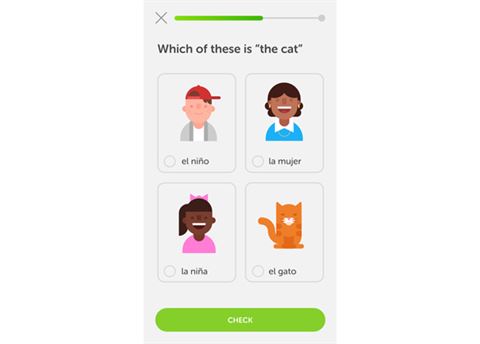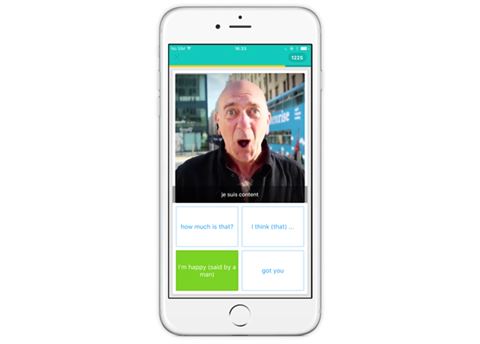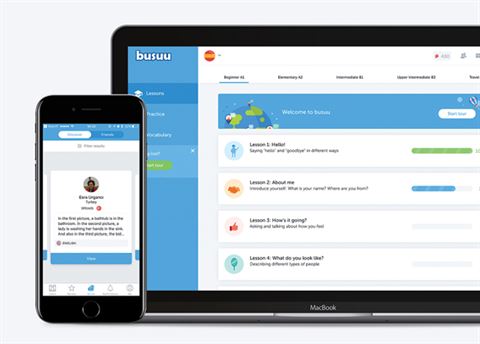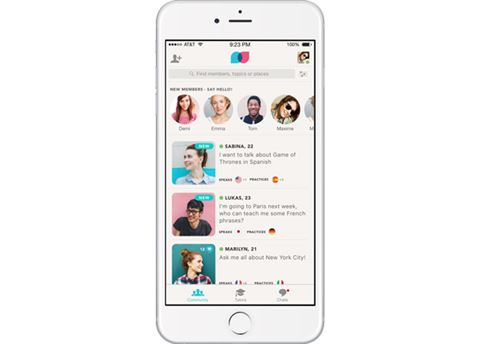THE GEAR • April 2018
Four handy apps to help learn a language
Preparing for a trip and keen to learn the lingo? Travel writer Rose Dykins puts four cutting-edge apps to the test in her quest to learn Spanish
Duolingo
How does it work? One of the most popular on the market, Duolingo instantly appeals with its simple interface and easy adaptability. Once you’ve selected your language and level of commitment – with options ranging from ‘casual’ (five minutes of learning per day) to ‘insane’ (20 minutes) – you’re thrown into a series of animated, picture-based games that teach you to associate words with text, images and audio. You’re gradually introduced to new elements, but the process moves quickly, keeping you on your toes. One useful feature is a game that teaches you to construct full sentences, rather than just key conversational phrases.
The verdict: Satisfying to use, the gamification didn’t appeal as much as the proud announcement that I was now ‘seven per cent fluent’. A good pace for beginners and fun, too. 9/10

Memrise
How does it work? Memrise begins with an introduction to individual words and phrases through text and audio, before moving on to memory-building exercises, then written tests. Particularly helpful are the video exercises featuring native speakers, where you are asked to identify phrases spoken by people with regional accents. As you progress, the app compiles a list of how many words you’ve learnt. It also tells you which phrases you have ‘mastered’ and which still need working on, based on your performance.
The verdict: Less comprehensive than the others, but the video content is fantastic. 8/10

Busuu
How does it work? Busuu lays the groundwork for users who are serious about becoming fluent. You are first asked to swipe through a series of flashcards showing phrases with accompanying audio pronunciation. You can play the audio at a slower speed if need be, and the app will occasionally ask you to recite a phrase into the microphone to check you’re saying it properly. Exercises are interspersed with pronunciation tips and explanations on how isolated sounds play a part in the language as a whole. Each session ends with a written or spoken exercise that is sent to the app’s community of native speakers for feedback.
The verdict: Forty-five minutes after submitting a voice recording, someone called Julio sent me a polite voice message telling me that I’d said “Very good” when I’d been asked “What’s your name?”. Great to have this human element and, out of all the apps, I was able to retain new words most effectively with this one. 10/10

Tandem
How does it work? This app offers a social network for exchanging language skills. Initially it can feel similar to a dating app, querying not only your learning goals but also your age, and the preferred age and gender of ‘your perfect Tandem buddy’. You must then wait to be initiated into the Tandem community – this can take seven days, or you can skip this by paying £6.49 for a one-month subscription. Before joining, you must sign a pledge to be respectful, and that you understand the app is not, in fact, for dating.You will then begin to receive messages from native speakers in your language of choice, who are also looking for reciprocal tuition.
The verdict: When my phone started pinging with messages from some 30 Spanish speakers, I became sceptical. But the more I used the app, the more I enjoyed helping others improve their English, and I learnt a few native phrases that my Spanish friends were delighted with. There’s an option to move on to video chat with Tandem buddies. Takes a while to set up, and not the best option for learning from scratch. Useful for getting that authentic touch so you sound like a person, not a textbook. 6/10

This article has been tagged Technology, Travel Tips
More from previous issues

Six essential items of road trip kit
Epic journeys call for great kit. These essential accessories will help you out in times of need, while ensuring you look the part

My Club: James Asquith
After visiting every country on the planet, Bronze Member James Asquith shares some of his travel experiences with The Club

Hip hangouts from New Orleans’ insiders
The Club talks to those who have the New Orleans vibe in their blood to find out where they eat, drink and party

The world’s best beer-drinking spots
Hopspots: beer aficionado Stephen Beaumont reveals the global locations where drinking his favourite libation is an experience to savour
